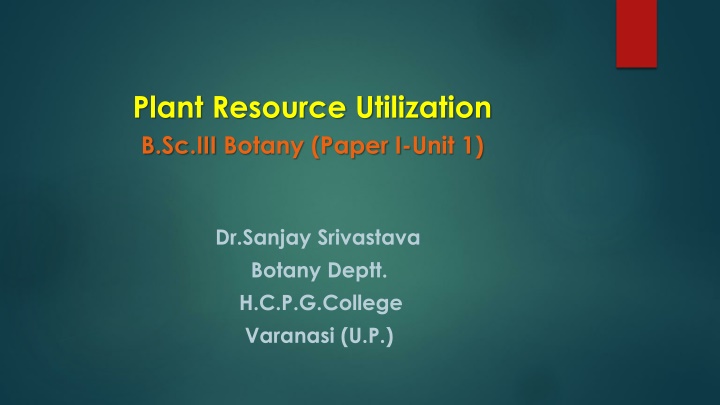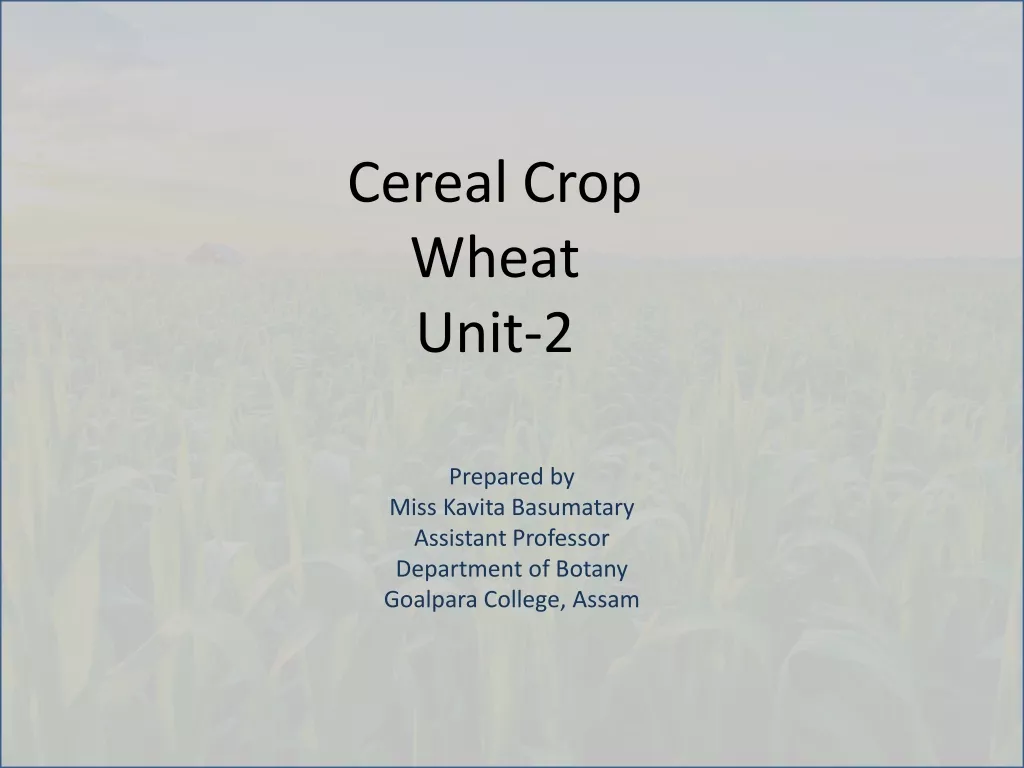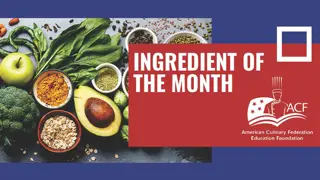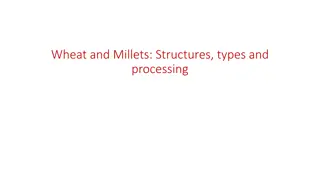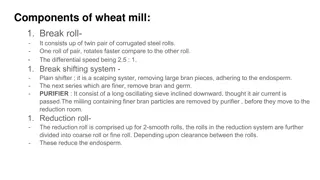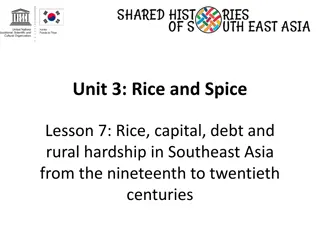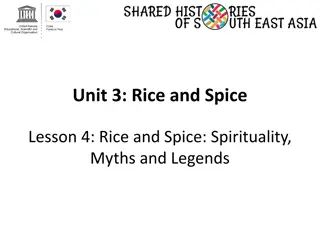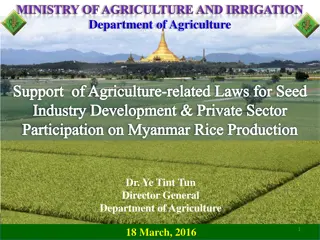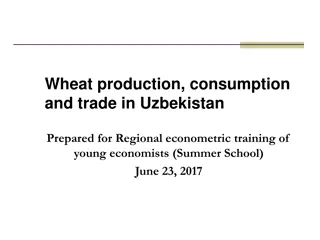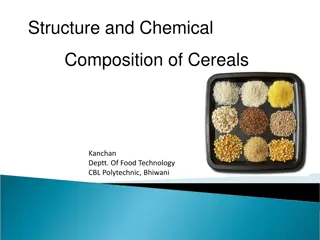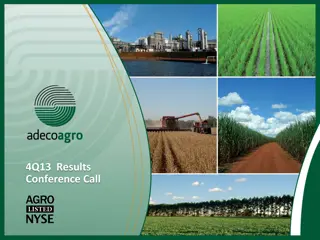Production and Uses of Wheat, Rice, Legumes, and Sugarcane
Cereals like wheat and rice, along with legumes such as pigeon pea and gram, play vital roles in food production and consumption. Wheat, known for its versatility in various forms like flour, bread, and beer, is a significant crop globally. Rice, a staple in many parts of the world, requires processing before consumption and finds diverse uses in industries. Legumes like pigeon pea and gram contribute to soil fertility and provide high protein content. Understanding the production and uses of these crops is essential for sustainable agriculture and food security.
Download Presentation

Please find below an Image/Link to download the presentation.
The content on the website is provided AS IS for your information and personal use only. It may not be sold, licensed, or shared on other websites without obtaining consent from the author.If you encounter any issues during the download, it is possible that the publisher has removed the file from their server.
You are allowed to download the files provided on this website for personal or commercial use, subject to the condition that they are used lawfully. All files are the property of their respective owners.
The content on the website is provided AS IS for your information and personal use only. It may not be sold, licensed, or shared on other websites without obtaining consent from the author.
E N D
Presentation Transcript
Plant Resource Utilization B.Sc.III Botany (Paper I-Unit 1) Dr.Sanjay Srivastava Botany Deptt. H.C.P.G.College Varanasi (U.P.)
Production and uses of Wheat Rice Legumes Sugarcane
CEREALS Wheat ( Gehun in Hindi) Scientific name : Triticum aestivum L. Family : Poaceae Wheat is most widely cultivated cereal crop of the world. In India, wheat is grown as a rabi crop i.e. a crop grown in winter season. The total area under wheat production in the country is around 30 million hectares. The all time highest output in India is 99.7 million tonnes. The average productivity is 3371 Kg/ha. Wheat plant attains a height of 2-5 feet. The inflorescence of plant is spike of spikelet. The fruit is caryopsis. It s edible part is fruit. The seed coat remains fused with the pericarp. Each grain has an outer husk, the proteinaceous aleurone layer, the endosperm containing starch and the embryo. Fruit straw is used as fodder and also for making mats and hats. Wheat flour is consumed in three forms- atta, maida and suji. It is used for making roti, bread, cakes, biscuits, pastries, noodles. It is also used for making beer and other alcoholic beverages through the process of fermentation.
Rice (Chaval or dhan in Hindi) Scientific name : Oryza sativa L. Family : Poaceae Rice is consumed as a part of staple diet in most parts of the world especially Asia. It is a staple food in eastern and southern parts of India. In India rice is a kharif crop i.e. a crop grown during monsoon season. Wet rice is grown in inundated lowlands of India whereas upland rice is grown on hilly areas. The edible part of the plant is fruit called caryopsis. The fruit wall or pericarp is fused with the seed coat. Grain along with the brown husk is called paddy. Grain contains large amount of carbohydrate along with some proteins, fats and minerals. The processed seeds need to be boiled or steamed before consuming. Rice bran oil is extracted from outer brown husk. It is used as edible oil and also for making soaps and cosmetics. It is also used in the preparation of alcoholic beverages. Rice straw is used for making strawboard, paper, mats etc.
LEGUMES (Pulses) Legumesare plants belonging to family Papilionaceae, grown for their high protein content and soil fertility enhancing property. Pigeon Pea (arhar or tur in Hindi) Scientific name : Cajanus cajan L. Family : Papilionaceae It is one of the most important pulse crop of India grown in kharif season. The total area under production in India is 3.90 Mha and production is around 3.17 MT. It is a shrub with 2-3 metre height. The pods of plant contain 4-5 seeds each. Seeds of plant are used as daal, traditionally taken with rice (daal chawal) in most parts of India. It has rich protein content. Green leaves and stem of plant are used as green manure.
Gram (chana in Hindi) Scientific name : Cicer arietanum L. Family : Papilionaceae It is also known as chickpea or Bengal gram and is a rabi season crop. Plants are small, bushy in appearance and cultivated in winter. The pod (fruit) contains 1-3 seeds. Seeds of gram are consumed in several forms. Seeds are consumed as dal. Gram Flour is called besan. Roasted gram flour is called sattu. Gram is rich in Protein. Besides it also contain carbohydrates and many vitamins also.
Soybean Scientific name : Glycine max (L.) Merr. Family : Papilionaceae Soybean is high protein (38-45%) legume crop. Many types of food items are prepared from soybean. In China, soybean is used to produce certain unfermented products such as soy milk from which tofu and tofu skin is prepared. Fermented soybean products include tempeh, sufu and soya sauce etc. According to a study fermentation increases the amount of phenolic compounds (anti-oxidant property) in soybean. Soybean is used to derive soybean oil. Soyabean chunks (soya bari) are quite popular in India. It is also used as animal feed in many parts of the world.
Garden Pea (matar in Hindi) Scientific name : Pisum sativum Family : Papilionaceae Garden pea is a herbaceous annual plant. The pod contain several seeds. Fresh seeds are consumed as vegetable. Dried seeds are used as dal. Plants are utilized as fodder and also for green manuring.
Black gram (Urd/Urad in Hindi) Scientific name : Vigna mungo (L.) Hepper Family : Papilionaceae The plants are annual herbs which are grown for their seeds. Wooly pods contain several seeds. Seeds are green or black in colour. Seeds are used as dal. Urad flour is used for making papad and badi. Plants are used as green manure and fodder.
Green gram (moong in Hindi) Scientific name : Vigna radiata Family : Papilionaceae Green gram is annual herb. Pods contain several seeds. Seeds are used as dal. Dal is easily digestible and given to patients. Moong flour is used for making papad. Plants are used as fodder and also for green manuring.
Ground nut/Pea nut (moongphali in Hindi) Scientific name : Arachis hypogea Family : Papilionaceae Plants are annual herbs which are bushy in appearance. It produces underground fruits. The ovaries after fertilization grow in positively geotropic manner and produce fruits underground. Roasted or fried seeds are eaten. Seeds have good amount of oil, proteins and vitamins. Groundnut oil is extracted from seeds. Peanut butter is also produced for consumption.
Sugarcane (Ganna or oonkh in Hindi) Scientific name : Saccharum officinarum Family : Poaceae Sugarcane is the world s largest crop under production. Roughly 80% of the sugar produced in the world comes from sugarcane. The stem is 2-6 metres in height. Stem is jointed, solid with nodes and internodes. The stem is rich in sucrose. The sugar juice is extracted from stem and converted into crystal form in sugar mills. It is also used for making jaggery (Gur) which is a traditional sweetener in rural India. The waste produced after juice extraction is called bagasse. Bagasse is used as a source of fuel. It is also used in making paper and cardboard. Molasses is a by-product of sugar industry which is fermented to produce alcohol, rum etc.
